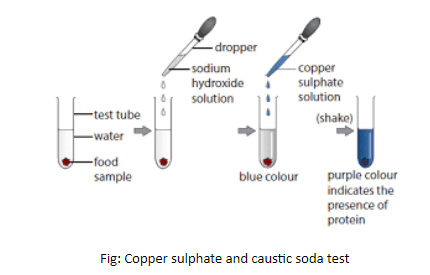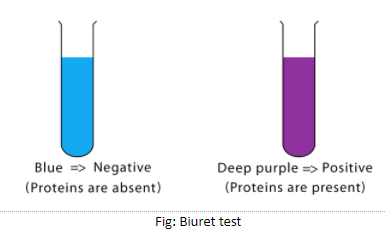
How can you test the presence of proteins in a given food item?
Answer
571.8k+ views
Hint: Almost all reactions involved in testing the presence of proteins in a given food item are chromogenic assays (i.e. colored products are formed).
Complete answer:
The presence of proteins in given foodstuff can be tested as follows:
Method 1: To test protein in the food we need a solution of copper sulfate and caustic soda.
- First we grinded the food sample finely (for example almonds).
- Then, we put it in a clean test tube followed by the addition of 10 drops of water.
- Added 2 drops of copper sulfate solution and shook it well.
- Added 10 drops of caustic soda solution and shook it well.
- The Violet color indicates the presence of proteins.

Fig: Copper sulphate and caustic soda test
Method 2: Biuret test –
- First we added the given sample food.
- We then added aqueous copper sulfate.
- The violet coloration confirms the presence of protein.

Fig: Biuret test
Method 3: Xanthoproteic test –
- First we added the given sample food.
- We then added the nitric acid.
- The yellow color solution confirms the presence of proteins.
Method 4: Millions test –
- First we added the given sample food.
- We then added the mercuric sulfate in the presence of sodium nitrite and sulfuric acid.
- The brick red color solution confirms the presence of proteins.
Method 5: Ninhydrin test –
- First we added the given sample food.
- We then added the pyridine solution of ninhydrin
- A Violet color solution confirms the presence of proteins.
Note: Biuret reagent solution can be prepared from copper sulfate, sodium/potassium hydroxide, and sodium tartrate. The above mentioned tests can be used for the different food materials and ease of the process.
Complete answer:
The presence of proteins in given foodstuff can be tested as follows:
Method 1: To test protein in the food we need a solution of copper sulfate and caustic soda.
- First we grinded the food sample finely (for example almonds).
- Then, we put it in a clean test tube followed by the addition of 10 drops of water.
- Added 2 drops of copper sulfate solution and shook it well.
- Added 10 drops of caustic soda solution and shook it well.
- The Violet color indicates the presence of proteins.

Fig: Copper sulphate and caustic soda test
Method 2: Biuret test –
- First we added the given sample food.
- We then added aqueous copper sulfate.
- The violet coloration confirms the presence of protein.

Fig: Biuret test
Method 3: Xanthoproteic test –
- First we added the given sample food.
- We then added the nitric acid.
- The yellow color solution confirms the presence of proteins.
Method 4: Millions test –
- First we added the given sample food.
- We then added the mercuric sulfate in the presence of sodium nitrite and sulfuric acid.
- The brick red color solution confirms the presence of proteins.
Method 5: Ninhydrin test –
- First we added the given sample food.
- We then added the pyridine solution of ninhydrin
- A Violet color solution confirms the presence of proteins.
Note: Biuret reagent solution can be prepared from copper sulfate, sodium/potassium hydroxide, and sodium tartrate. The above mentioned tests can be used for the different food materials and ease of the process.
Recently Updated Pages
Master Class 12 Business Studies: Engaging Questions & Answers for Success

Master Class 12 Economics: Engaging Questions & Answers for Success

Master Class 12 English: Engaging Questions & Answers for Success

Master Class 12 Maths: Engaging Questions & Answers for Success

Master Class 12 Social Science: Engaging Questions & Answers for Success

Master Class 12 Chemistry: Engaging Questions & Answers for Success

Trending doubts
What is meant by exothermic and endothermic reactions class 11 chemistry CBSE

Which animal has three hearts class 11 biology CBSE

10 examples of friction in our daily life

One Metric ton is equal to kg A 10000 B 1000 C 100 class 11 physics CBSE

1 Quintal is equal to a 110 kg b 10 kg c 100kg d 1000 class 11 physics CBSE

Difference Between Prokaryotic Cells and Eukaryotic Cells




